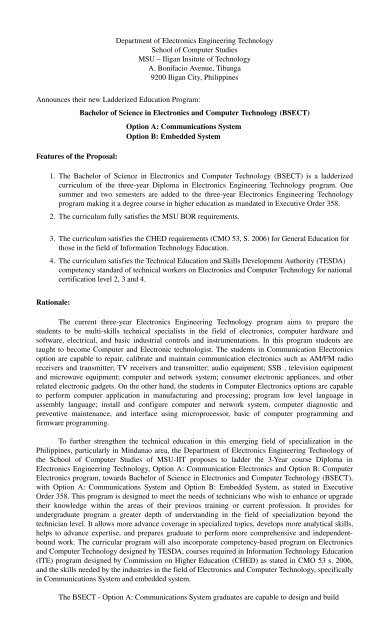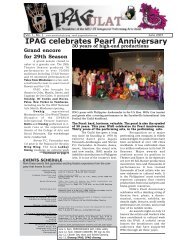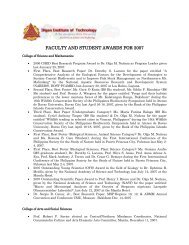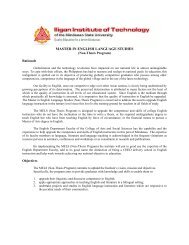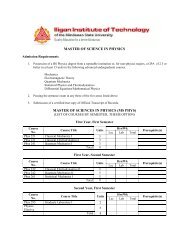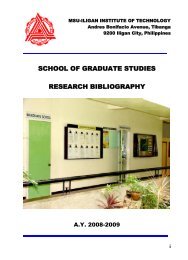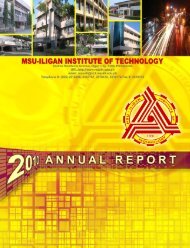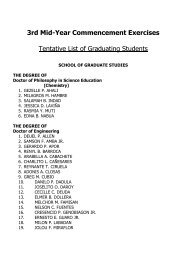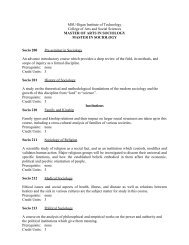Department of Electronics Engineering Technology - Iligan Institute ...
Department of Electronics Engineering Technology - Iligan Institute ...
Department of Electronics Engineering Technology - Iligan Institute ...
You also want an ePaper? Increase the reach of your titles
YUMPU automatically turns print PDFs into web optimized ePapers that Google loves.
<strong>Department</strong> <strong>of</strong> <strong>Electronics</strong> <strong>Engineering</strong> <strong>Technology</strong><br />
School <strong>of</strong> Computer Studies<br />
MSU – <strong>Iligan</strong> Insitute <strong>of</strong> <strong>Technology</strong><br />
A. Bonifacio Avenue, Tibanga<br />
9200 <strong>Iligan</strong> City, Philippines<br />
Announces their new Ladderized Education Program:<br />
Features <strong>of</strong> the Proposal:<br />
Bachelor <strong>of</strong> Science in <strong>Electronics</strong> and Computer <strong>Technology</strong> (BSECT)<br />
Option A: Communications System<br />
Option B: Embedded System<br />
1. The Bachelor <strong>of</strong> Science in <strong>Electronics</strong> and Computer <strong>Technology</strong> (BSECT) is a ladderized<br />
curriculum <strong>of</strong> the threeyear Diploma in <strong>Electronics</strong> <strong>Engineering</strong> <strong>Technology</strong> program. One<br />
summer and two semesters are added to the threeyear <strong>Electronics</strong> <strong>Engineering</strong> <strong>Technology</strong><br />
program making it a degree course in higher education as mandated in Executive Order 358.<br />
2. The curriculum fully satisfies the MSU BOR requirements.<br />
3. The curriculum satisfies the CHED requirements (CMO 53, S. 2006) for General Education for<br />
those in the field <strong>of</strong> Information <strong>Technology</strong> Education.<br />
4. The curriculum satisfies the Technical Education and Skills Development Authority (TESDA)<br />
competency standard <strong>of</strong> technical workers on <strong>Electronics</strong> and Computer <strong>Technology</strong> for national<br />
certification level 2, 3 and 4.<br />
Rationale:<br />
The current threeyear <strong>Electronics</strong> <strong>Engineering</strong> <strong>Technology</strong> program aims to prepare the<br />
students to be multiskills technical specialists in the field <strong>of</strong> electronics, computer hardware and<br />
s<strong>of</strong>tware, electrical, and basic industrial controls and instrumentations. In this program students are<br />
taught to become Computer and Electronic technologist. The students in Communication <strong>Electronics</strong><br />
option are capable to repair, calibrate and maintain communication electronics such as AM/FM radio<br />
receivers and transmitter; TV receivers and transmitter; audio equipment; SSB , television equipment<br />
and microwave equipment; computer and network system; consumer electronic appliances, and other<br />
related electronic gadgets. On the other hand, the students in Computer <strong>Electronics</strong> options are capable<br />
to perform computer application in manufacturing and processing; program low level language in<br />
assembly language; install and configure computer and network system, computer diagnostic and<br />
preventive maintenance, and interface using microprocessor, basic <strong>of</strong> computer programming and<br />
firmware programming.<br />
To further strengthen the technical education in this emerging field <strong>of</strong> specialization in the<br />
Philippines, particularly in Mindanao area, the <strong>Department</strong> <strong>of</strong> <strong>Electronics</strong> <strong>Engineering</strong> <strong>Technology</strong> <strong>of</strong><br />
the School <strong>of</strong> Computer Studies <strong>of</strong> MSUIIT proposes to ladder the 3Year course Diploma in<br />
<strong>Electronics</strong> <strong>Engineering</strong> <strong>Technology</strong>, Option A: Communication <strong>Electronics</strong> and Option B: Computer<br />
<strong>Electronics</strong> program, towards Bachelor <strong>of</strong> Science in <strong>Electronics</strong> and Computer <strong>Technology</strong> (BSECT),<br />
with Option A: Communications System and Option B: Embedded System, as stated in Executive<br />
Order 358. This program is designed to meet the needs <strong>of</strong> technicians who wish to enhance or upgrade<br />
their knowledge within the areas <strong>of</strong> their previous training or current pr<strong>of</strong>ession. It provides for<br />
undergraduate program a greater depth <strong>of</strong> understanding in the field <strong>of</strong> specialization beyond the<br />
technician level. It allows more advance coverage in specialized topics, develops more analytical skills,<br />
helps to advance expertise, and prepares graduate to perform more comprehensive and independentbound<br />
work. The curricular program will also incorporate competencybased program on <strong>Electronics</strong><br />
and Computer <strong>Technology</strong> designed by TESDA, courses required in Information <strong>Technology</strong> Education<br />
(ITE) program designed by Commission on Higher Education (CHED) as stated in CMO 53 s. 2006,<br />
and the skills needed by the industries in the field <strong>of</strong> <strong>Electronics</strong> and Computer <strong>Technology</strong>, specifically<br />
in Communications System and embedded system.<br />
The BSECT Option A: Communications System graduates are capable to design and build


